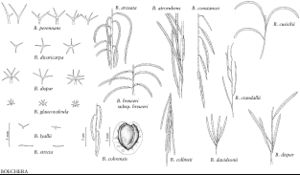Boechera davidsonii
in A. Cronquist et al., Intermount. Fl. 2(B): 368. 2005.
Perennials; long-lived; (cespitose); sexual; caudex woody (thickly covered by persistent, crowded leaf-bases). Stems usually 1 per caudex branch, arising from center of rosette near ground surface, 0.6–2.3 dm, glabrous throughout. Basal leaves: blade oblanceolate, 3.5–14 mm wide, margins usually entire, rarely slightly dentate, not ciliate, surfaces glabrous. Cauline leaves: 3–10, not concealing stem; blade auricles absent, glabrous. Racemes 4–24-flowered, usually unbranched. Fruiting pedicels ascending, straight, 3–18 mm, glabrous. Flowers ascending at anthesis; sepals glabrous; petals white to lavender, 6–10 × 2.5–4 mm, glabrous; pollen ellipsoid. Fruits ascending to divaricate-ascending, not appressed to rachis, not secund, straight to slightly curved, edges parallel, 2.5–7 cm × 1.5–2.5 mm; valves glabrous; ovules 28–50 per ovary; style 0.1–0.8 mm. Seeds uniseriate, 1.8–2.2 × 0.8–1.7 mm; wing distal or continuous, 0.1–0.5 mm wide.
Phenology: Flowering Apr–Jul.
Habitat: Ledges and crevices of rock outcrops
Elevation: 1200-3400 m
Distribution

Calif., Nev., Oreg.
Discussion
Plants of Boechera davidsonii sometimes are confused with completely glabrous individuals of B. lyallii, and G. A. Mulligan (1996) treated it as a synonym of the latter. It is easily distinguished from B. lyallii by the thick covering of persistent leaf bases on caudex branches, ascending (versus erect and appressed) fruits, and uniseriate (versus biseriate to sub-biseriate) seeds. Boechera davidsonii is nearly unique among western North American species of the genus in showing no evidence of hybridization with other species.
Selected References
None.
Lower Taxa
"elongated" is not a number."thick" is not a number."dm" is not declared as a valid unit of measurement for this property.
